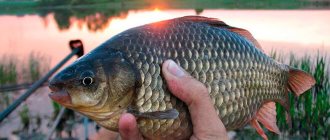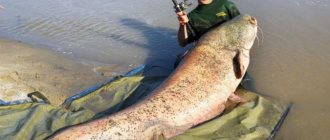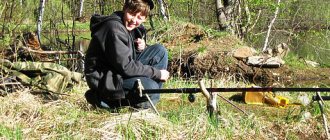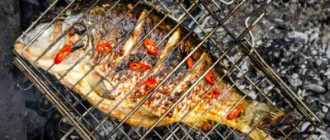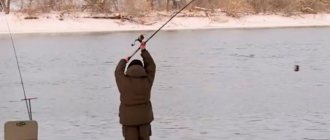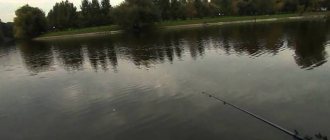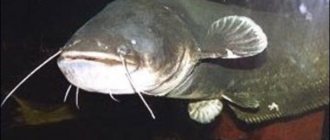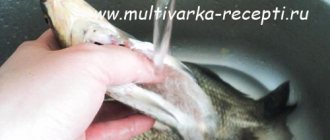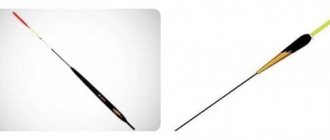The bite of crucian carp depending on the month of fishing
The nature of fishing for crucian carp, like other fish, has pronounced seasonal characteristics. Let us dwell in detail on the features of crucian carp fishing in the autumn months.
| September | October | November |
| In September, compared to summer, there is a decrease in feeding activity, and as a consequence, the efficiency of catching crucian carp. This is due to a gradual decrease in air and water temperatures. However, taking into account some features, you can catch crucian carp in September in no less quantities than in summer. Successful fishing for crucian carp at this time can be observed in deep reservoirs with a significant current. Small rivers with weak currents are usually distinguished by the formation of different bottom conditions that are suitable for the activity of crucian carp. In such places, feeder, picker and half-bottom are used for fishing. As experience shows, crucian carp reaches its greatest activity in September closer to noon. In warm weather, activity occurs earlier; in cold weather, activity occurs later. Usually the bite ends by 15-16 hours. Since crucian carp feed in large concentrations in September, choosing a good place can bring a good catch. At this time, the crucian carp bite is also very dependent on the weather. Crucian carp prefers clear weather, so in strong winds and heavy clouds the biting intensity is significantly reduced. | Due to the colder weather, the activity of crucian carp decreases sharply. In October, an increase in the activity of crucian carp is observed from the very early morning until 10 o’clock. There is also a surge in activity 1-1.5 hours before sunset and until complete darkness. The best weather for fishing is a clear day with normal atmospheric pressure that has been established for 2-3 days, since it is believed that crucian carp are able to detect weather changes in advance. In October, crucian carp go to the bottom, so the working depth is 3–5 meters. The greatest likelihood of finding crucian carp at this time is associated with flowing reservoirs rich in aquatic vegetation, as well as river bays with a small current. | Increasing cold forces the crucian carp to lie down on the bottom. In November, the greatest biting activity is observed in the middle of the day with clear weather, when the water warms up. This leads to an increase in the activity of crucian carp, which increases the chance of tempting it with a well-chosen bait. In other weather, the chance of catching crucian carp is significantly reduced. Since water transparency increases when the water temperature drops, when catching crucian carp you need to use the thinnest possible line, which increases the efficiency of fishing. When fishing for crucian carp in November, the bait should be located almost at the depth of the bottom, where crucian carp hides in cold weather. |
Crucian carp in autumn. Features of behavior
Fishing experience and the practice of underwater hunters indicate that crucian carp in the fall changes its behavior throughout this time of year. The activity of crucian carp is influenced by the difference in day and night temperatures and changes in atmospheric pressure. In addition, it should be taken into account that the behavior of fish in stagnant bodies of water differs from its activity in rivers. The presence of pike and large perch in the reservoir contributes to a reduction in the crucian carp population.
Crucian carp in September. In the first half of September, active crucian carp, weighing 100-300 g, is found throughout the entire water area of the reservoir. Large individuals move along bottom depressions. With the onset of night, trophy crucian carp can approach the coastal zone overgrown with reeds. Fishing for crucian carp at night in September can delight you with the capture of a trophy specimen.
Crucian carp in October. Already from the second half of September and throughout October, the difference between night and day temperatures increases. In October, on sunny, windless days, crucian carp continues to fatten up before wintering. The basis of the food consists of dying aquatic plants and bottom insects that did not have time to burrow into the silt. The best time for fishing for crucian carp this month is from 10 a.m. to 11 p.m. After midnight and at dawn, the temperature becomes lower, and satiated crucian carp stops rushing around the reservoir in search of food.
Crucian carp in November. The behavior of crucian carp in November depends on the natural conditions of the reservoir. If the bottom of the lake (pond) is covered with a thick (over 20 cm) ball of silt, then after stable frosts occur, the crucian carp buries itself in the silt, and in this state it experiences a period of freeze-up. In ice-free reservoirs and large rivers, large fish concentrate in the bottom depressions. Successful fishing for crucian carp in November is possible on relatively warm days, throughout the day.
Fishing for crucian carp on a feeder
The main article on feeder fishing for crucian carp is here.
As you know, a feeder is a bottom fishing rod in which a feeder weight is used instead of a simple load. As a rule, a filler is used when it is necessary to fish at significant distances from the shore and at sufficiently large depths. This tackle is characterized by high sensitivity and low responsiveness to the wind.
In the fall, a feeder is ideal for catching crucian carp, which is capable of working at great depths, where crucian carp is almost constantly located in the autumn.
The beginning of autumn is characterized by increased feeding of crucian carp to store fat for the winter, so there is every chance of getting a rich catch. At this time, crucian carp gives preference to animal food: bloodworms, worms, maggots. It is these components that must be included in the autumn bait for crucian carp, which, moreover, must be well crushed.
Feeder equipment “symmetrical loop”
When using a feeder, special attention should be paid to the thickness of the leash. It should not exceed 0.14 mm, if possible – 0.10–0.12 mm. For fishing with bloodworms and maggots, hooks No. 18–22 are used, and for worms – No. 16–18. In some cases, amazing results are obtained when using a bread attachment. In this case, it is useful to add soaked bread crumbs to the bait composition.
Baits and baits for autumn crucian carp fishing
The amount and composition of bait directly depends on the water temperature. The colder the water, the poorer the composition and the more animal components and less plant components. It is very important to find the habitat of crucian carp. If in summer it is still possible to attract a large number of specimens from distant points, then in autumn it is very difficult, almost impossible. Therefore, we choose the places indicated above.
If we fish with a float rod, then we roll balls, add soil or sand with clay, chopped worms and medium-sized bloodworms. It is better not to use large grains so as not to overfeed. It is better to use boiled millet mixed with corn flour and hemp oil or molasses. These components activate the appetite of crucian carp and you can count on the constant presence of fish at the point.
With further cooling, we use less bait and focus on bloodworms and spices: ground coriander, cinnamon and add more soil and chopped worms. The result will be an earthy and heavy bait with bloodworms and a worm.
It is better to feed abundantly immediately in the fall, and then only supplement in small portions. The best option is to feed several promising places at once, and then fish on them. When fishing with a feeder, it makes sense to change the feeder to a smaller one or to a weight. At later and cooler times, casts should be made every 15 minutes.
When fishing on a float rod, make the balls the size of a tangerine and throw them one at a time during the fishing process. Again, the fisherman’s task is not to overfeed. If the bite is good, we don’t feed. We feed only if there are no bites at all.
In the second half of autumn, the best bait for crucian carp is medium-sized bloodworms mixed with soil or sand. It is enough to take 50 grams of bloodworms. It should be used in cases where there are few perch in the reservoir. If this predator predominates, then it is better to use small maggots. You can also use cold water bait with the scent of anise.
The best baits for fishing crucian carp in the fall will be an ordinary dung worm and maggot. At the end of autumn, bloodworms come first. In September, when fishing with fishing rods, chatterfish with the scent of anise and vanilla, as well as pearl barley in breadcrumbs, work very well. You can use sandwiches. For crucian carp, successful combinations are a worm with maggots, pearl barley with bloodworms and mash with maggot. In general, when fishing for crucian carp it is very important to have a sufficient number of baits. This gourmet loves to tickle the nerves of anglers and is often picky.
Sometimes such unusual combinations of nozzles shoot out that you can only be surprised. Sometimes it happens that after unsuccessful attempts to fish with various delicacies, an ordinary stale piece of bread with garlic turns out to be the best bait of the day. Fishermen standing nearby may be distressed and suspect you of using a secret drug. However, any of them could be in your place. It’s just that the crucian carp chose you on this day. On the next fishing trip, someone else will be pompously pulling out these big beauties, fishing with simple pearl barley without flavorings or crackers.
In lakes and calm sections of rivers, crucian carp can actively peck only on black bread until the onset of frost. In general, in different bodies of water, the preferences of crucian carp can differ significantly. Therefore, if you don’t know the reservoir well, then ask local fishermen about the preferences of crucian carp at this time.
Catching crucian carp with a float rod
Needed to study:
- How to choose the right float for crucian carp
- Guide to fishing for crucian carp with a float
Correct sensitive loading of the float on crucian carp
When catching crucian carp with a fishing rod in the fall, you must remember that at this time the crucian carp is at significant depths - more than 3-4 meters. Based on this, the fishing rod should have a sufficiently long fishing line. It is advisable to use a main line with a diameter of about 0.15 mm and a thin leader with a diameter of 0.08–0.1 mm. The length of the rod that is used in this case, as a rule, reaches a length of 3 meters. If the fishing rod has a reel, you must use its inertia-free variety. The float is used sliding. It is important to use the correct weight, because in the fall the crucian carp takes the bait very carefully. If the fish feels resistance, it will immediately throw out the bait.
The bite of crucian carp is characteristic only of this type of fish. At first, the float trembles slightly, then suddenly lies down on the water and moves to the side. This is the perfect moment to strike.
What do crucian carp bite on in the fall?
Crucian carp in the fall shows its whims to the maximum. The bite is unpredictable. Active biting can begin at any time during the day. Therefore, when going out to a reservoir for crucian carp, there is no point in focusing on a specific time period.
In the first half of autumn, crucian carp are more willing to bite on plant fishing baits. But this does not mean that you need to exclude the red worm, caddis larva, bloodworms or maggots. They attract fish and “sandwiches” well. Combinations of baits and attachments can be very different. After identifying a promising bait, it is taken as a basis. With the onset of no-biting, you should continue experimenting with attachments and baits. To attract fish to the fishing site, autumn bait for crucian carp is used.
In cool water, crucian carp bite better on bait. But, again, if there are no bites for more than an hour, you should check the fish’s reaction to plant baits. Already from the second half of October, you need to look for crucian carp in holes and bottom depressions in areas with differences in depth. In November, fish rarely move around the reservoir. Although the use of bait will not be superfluous. Complementary food is thrown into the exit points from the bottom pits.
Techniques for catching crucian carp in autumn
When fishing with a float rod and rubber band, the approach of crucian carp to the bait can be determined by the bite alarm. The fact that the fish is interested in the offered bait is indicated by a slight but frequent twitching of the float. At this moment you need to show restraint and not rush into hooking. You need to hook when the float is pulled to the side, under the water or when it is laid out on the water surface. A crucian carp caught on a hook tends to go into the existing thickets. This cannot be allowed.
Feeder fishing is designed for self-hooking fish. But there is no need to delay cutting. As soon as the bell or bell rings sharply and the tip of the rod begins to actively bend, you need to hook. When playing fish from a long distance, you should force its approach to the shore. It all depends on the strength of the equipment. Retrieving large crucian carp ashore or into a boat is done using a landing net.
So, with careful preparation for fishing for crucian carp in the fall, you can count on a good catch.
